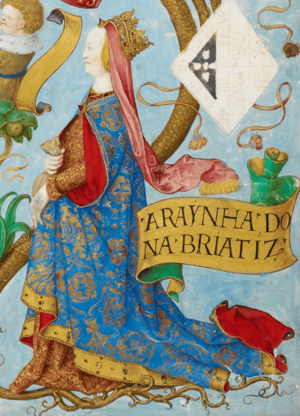Beatrice of Castile (1242–1303) facts for kids
Quick facts for kids Beatrice of Castile |
|
|---|---|

Beatrice of Castile, in Antonio de Hollanda's Genealogy of the Royal Houses of Spain and Portugal (1530–1534)
|
|
| Queen consort of Portugal | |
| Tenure | 1253 – 16 February 1279 |
| Born | 1242/44 |
| Died | 7 August 1300 |
| Burial | Monastery of Alcobaça |
| Spouse | |
| Issue among others... |
|
| House | Castilian House of Ivrea |
| Father | Alfonso X of Castile |
| Mother | Mayor Guillén de Guzmán |
| Religion | Roman Catholicism |
Beatrice of Castile (born between 1242 and 1244 – died August 7, 1300) was an important queen in Portuguese history. She was the daughter of Alfonso X of Castile, a king from Spain, and his partner Mayor Guillén de Guzmán. Beatrice became the second Queen consort of Afonso III of Portugal. A queen consort is the wife of a reigning king.
Contents
Early Life and Marriage
Beatrice was likely born around 1244. Her father, King Alfonso X, gave her and her siblings some land in a place called Elche when she was very young.
Later, King Alfonso X wanted to make a peace agreement with the Kingdom of Portugal. To do this, he offered his daughter Beatrice to marry King Afonso III of Portugal. The wedding happened in 1253.
As part of their agreement, King Alfonso X promised to give his rights to the Algarve region to the first son born to Afonso III and Beatrice. This would happen when their son turned seven years old.
At the time of the wedding, King Afonso III was still married to another queen, Matilda II of Boulogne. This caused some problems, and Matilda even complained to the Pope. However, Matilda passed away in 1255, which solved the issue.
Life as Queen
Queen Beatrice had a lot of influence in the Portuguese royal court during her husband's reign. She worked to bring the kingdoms of Portugal and Castile closer together.
When her mother, Mayor Guillén de Guzmán, died around 1267, Beatrice inherited many lands. These included places like Cifuentes and Alcocer. In Alcocer, she took care of the Monastery of Santa Clara, which her mother had started.
In 1282, Queen Beatrice returned to Seville in Spain. She had some disagreements with her son, King Denis, who was now the King of Portugal. Even though she was a widow, she strongly supported her father, King Alfonso X, in a disagreement he had with her half-brother Sancho IV of Castile.
King Alfonso X gave Beatrice more lands, including the towns of Mourão, Serpa, and Moura, along with their castles. He also gave her the Kingdom of Niebla and some royal taxes from the city of Badajoz. Beatrice stayed with her father until he passed away in 1284.
Queen Beatrice died on August 7, 1300. She was buried at the Monastery of Alcobaça in Portugal.
Children of Beatrice and Afonso III
Beatrice was about 11 years old when she married King Afonso III, who was 42. They had several children together:
| Name | Birth | Death | Notes |
|---|---|---|---|
| Branca | February 25, 1259 | April 17, 1321 | She was the Lady of Las Huelgas. |
| Dinis | October 9, 1261 | January 7, 1325 | He became the 6th King of Portugal after his father. He married Elizabeth of Aragon. |
| Afonso | February 8, 1263 | November 2, 1312 | He was the Lord of Portalegre. He married Violante Manuel. |
| Sancha | February 2, 1264 | around 1302 | |
| Maria | 1265 | around 1266 | |
| Vicente | 1268 | 1268 | |
| Fernando | 1269 | 1269 |
Ancestry
| Ancestors of Beatrice of Castile | |||||||||||||||||||||||||||||||||||||||||||||||||||||||||||||||||||||||||||||||||||||||||||||||||||||||||||||||||||||||||||||||||||||||||||||||||||||||||||||||||||||||||||||||||||||||||||||||||||||||||||||||||||||||||||||||||||||||||||||||||||||||||||||||||||||||||||||||||||||||||
|---|---|---|---|---|---|---|---|---|---|---|---|---|---|---|---|---|---|---|---|---|---|---|---|---|---|---|---|---|---|---|---|---|---|---|---|---|---|---|---|---|---|---|---|---|---|---|---|---|---|---|---|---|---|---|---|---|---|---|---|---|---|---|---|---|---|---|---|---|---|---|---|---|---|---|---|---|---|---|---|---|---|---|---|---|---|---|---|---|---|---|---|---|---|---|---|---|---|---|---|---|---|---|---|---|---|---|---|---|---|---|---|---|---|---|---|---|---|---|---|---|---|---|---|---|---|---|---|---|---|---|---|---|---|---|---|---|---|---|---|---|---|---|---|---|---|---|---|---|---|---|---|---|---|---|---|---|---|---|---|---|---|---|---|---|---|---|---|---|---|---|---|---|---|---|---|---|---|---|---|---|---|---|---|---|---|---|---|---|---|---|---|---|---|---|---|---|---|---|---|---|---|---|---|---|---|---|---|---|---|---|---|---|---|---|---|---|---|---|---|---|---|---|---|---|---|---|---|---|---|---|---|---|---|---|---|---|---|---|---|---|---|---|---|---|---|---|---|---|---|---|---|---|---|---|---|---|---|---|---|---|---|---|---|---|---|---|---|---|---|---|---|---|---|---|---|---|---|---|---|---|---|
|
|||||||||||||||||||||||||||||||||||||||||||||||||||||||||||||||||||||||||||||||||||||||||||||||||||||||||||||||||||||||||||||||||||||||||||||||||||||||||||||||||||||||||||||||||||||||||||||||||||||||||||||||||||||||||||||||||||||||||||||||||||||||||||||||||||||||||||||||||||||||||
See also
 In Spanish: Beatriz de Castilla para niños
In Spanish: Beatriz de Castilla para niños

